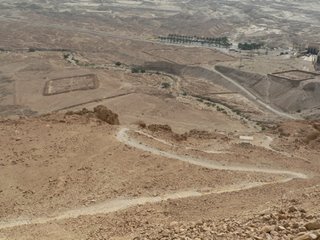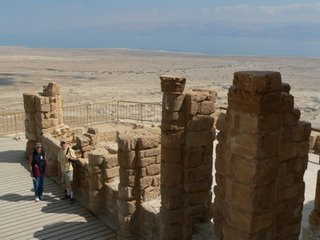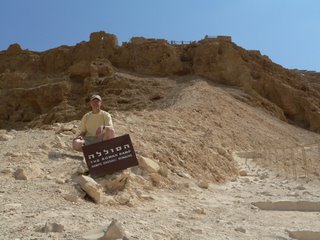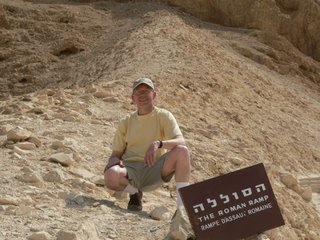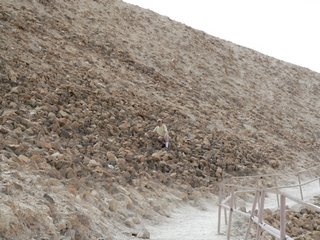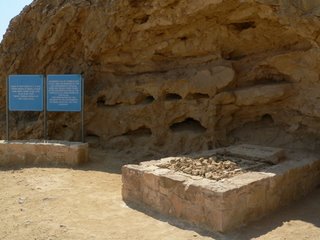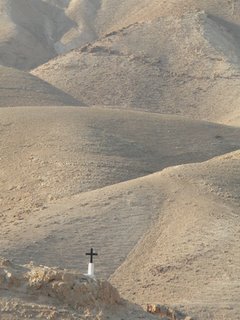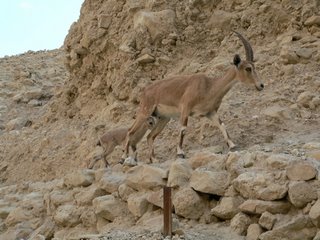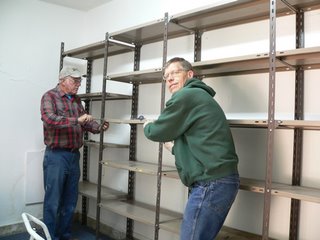




Photos: working in the Jewish apartments, installing handrails. Larry, James, and I at work. The daughter of one of the residents--a Christian Jew from Sri Lanka! Me drinking tea and eating cookies provided by one of the elderly. The old neighborhood where we worked; Larry and I in the foreground.
It’s Friday night, and shabbat has begun. Jerusalem is quiet, because all Jews (secular and religious alike) observe the sabbath, completely refraining from work, travel, and activity. People stay at home, relaxing with family and friends, enjoying food and rest, avoiding regular, everyday life and routine, only going out for worship. I’m spending the evening reflecting on the incredible sabbatical experience I’m having here in Israel. Let me share with you what my week has been like, and what has become my routine as I share in the ministry of Bridges For Peace.
We start each day together at the Distribution Center with devotions, led by different volunteers and staff members, at 8:30 a.m. This means I have to be up at 6:00 every morning so I can be ready to catch my ride to the Center at 7:15. It has been tough waking up this early every day--not at all what I’m used to in Hilmar! Fortunately it’s getting light by 5:30 so this helps me get up and into the shower! My home repair team supervisor, James (a South African), picks me up along with Larry and Mary Bennett (from Great Falls, Montana) so we don’t have to take the bus from where we live at BFP headquarters the 5 miles to the Center. James always has paper work to catch up on, or project details to organize, so that’s why we go so early. Larry and Mary and I get coffee going, set up chairs for devotions, chat with people as they arrive, go shopping for our groceries and supplies at a large supermarket behind the Center, and help get food ready for the day’s deliveries when extra assistance is needed.
It is wonderful to begin our day together as a staff worshiping the Lord, praying, and being challenged by the person offering devotions for the day. Everyone who works here is deeply committed to Christ, and to the ministry of BFP, and the strength of our community can be felt as we prepare to serve the Lord for the day by focusing on Him during this devotional time.
However, at 9:00 a.m., every day is different for those of us on the home repair team! And I love it, being out at different locations, doing different projects, learning new skills, and enjoying the comradery of my team friends.
Monday: Larry and I finished installing a laarge shelving unit in the storage room, then cleaned up everything we’d worked on in the new kitchen so it would leave a good impression when the BFP international board (who met here all week) toured headquarters. I also helped Bob (our electrician, from South Africa) repair a washing machine for an Ethiopian priest who lives by the Bridges office.
Tuesday: I painted windows in the teaching room to match the ones I painted with Dave (from Florida) during my first week of home repair work. At lunch time, I went for my first run in Jerusalem with Barry (a Messianic Jew from Brooklyn who moved to Israel some years ago) and I had a marvelous time jogging along the Old City wall and through different neighborhoods--as Barry boldly prayed out loud as we passed Jews, Palestinians, soldiers, police, and people dressed up in all kinds of crazy costumes for Purim (more on this holiday later).
Wednesday: Our entire team worked at headquarters, and I spent the morning painting the window frames in the teaching room so everything will match inside. I am getting real good at painting! I can now do a decent straight line with a good bead of paint on the edge of my brush, and no guide to help me. In the afternnoon, we drove to En Karem, the birthplace of John the Baptist on the edge of the city, where BFP has had their “Land of the Bible” education center. They have to close up this very impressive facility and dismantle all of the teaching aids (threshing floor, wine press, pulley system to hoist huge blocks of stone, bedouin tent, biblical dinner table, olive oil press, crucifixion “trees,” first century tomb, etc.). The plan is to scale it down and move it to headquarters, instead of paying extra rent at this location which is miles away from BFP. Our team looked over everything and made some preliminary plans on how to proceed with the job, which is certainly going to be a huge project.
Thursday: The day began with an hour-long “praise and worship” gathering and a meditation by the BFP board chairman. This brought the headquarters staff and Center workers together for morning devotions. It was the second time that we were together this week, and it gave me another opportunity to meet more of these gifted and committed people. Then James and Larry and I spent the day (finally!) in the homes of Jewish people, helping them with their needs. Larry had welded a bunch of handrails to install in the dingy stairways of some elderly Jews, so this is what we did all day. We drove to an older, dilapidated section of Jerusalem which has some of the original apartments that were quickly built in 1948 when Israel first became a nation and the new immigrants were young and excited about the future--but now these Israelis are old, living in poverty, and unable to maintain their poorly constructed dwellings. It was a privilege to serve them in this very simple way--basic handrails to help them walk up the stairs to their homes--and to see how grateful they were for even this little gesture of care and concern.
Fridays are only half days of work, because shabbat begins at sundown and the buses, which most BFP people take to work, stop running in the afternoon. I returned to painting today, cleaning and coating a large cupboard unit that needs to be mounted in the Center’s food bank. I was glad to be indoors working on this project because it turned cold again this morning! Fridays are also more casual and laid back at the Distribution Center. Fewer people are served (they are busy at home getting ready for shabbat) and often the week’s deliveries are completed. Volunteers and staff talk together, drink more tea and coffee, and do clean-up and organizing until we head for home to prepare for shabbat ourselves.
I headed to the “shuk” as soon as I got off the bus (a 10 minute walk from my apartment) to do my own shopping. It’s always kind of crazy here, but even moreso on Friday afternoon! People are rushing and scrambling to get everything they need for shabbat and vendors are shouting and pushing their fresh goods and merchandise to get rid of all they can before sundown. There is a lot of jostling, shoving, bumping, and human gridlock, as carts of supplies push people to the sides of the narrow streets, shoppers stop all of a sudden to buy something, children squeeze through people to find candy and toys, and all the loaded shopping carts, bags,sacks, and backpacks generally get in everyone’s way. It’s a blast! I’d love to take all of you to the shuk for the experience. I bought 5 fresh pitas, still hot from the oven (5 shekels), hummus and a red pepper/onion/cumin dip that is fantastic (10 shekels), over one pound of beautiful dried apricots (12 shekels), more fresh strawberries (12 shekels for more than one kilo--almost 3 pounds), and I splurged and bought three sweet phyllo dough pastries (chocolate, almond, cinnamon) for just 2 shekels. These are wonderful to indulge in with a good cup of coffee as shabbat begins.
Most days after work, I wash up, change clothes, and walk to Ben Yehuda Mall and Jaffa Street, just two blocks from where I live, to get some exercise, watch people, shop, and stop for a mocha or latte at “Cafe Hillel,” a Starbuck’s-like coffeehouse that is comfortable and filled with young people speaking all kinds of languages. I take something to read, postcards to write, or just sit and enjoy the milieu of the cafe. This is a wonderful way to relax, unwind from the day, experience a unique part of Jerusalem life, and get ready for my evening, which I usually spend alone at home. I usually have prayer time when I get back to my apartment, make dinner, then write in my journal, my blog, work with my digital pictures, read, do emails--and before I know it, it’s time for bed!
During the week, it is rather nice to have quiet nights by myself because I spend every day at lunch socializing with other BFP people. This is always a fun time of conversation, learning about people’s lives and weekend adventures, sharing food, and hearing news. It is especially nice to eat lunch in the headquarters kitchen with the staff because otherwise I don’t get much of a chance to be with them. Because we come from all over the world--South Africa, England, New Guinea, Japan, Korea, Russia, Australia, New Zealand, Germany, France, Canada, and the USA--it is very interesting to share together about where we come from and our experiences of life.
On Tuesday night though, we had a huge potluck/celebration evening together to honor and say farewell to Carol Carlson, the receptionist secretary who has been with Bridges For Peace for 18 years. The Israeli government won’t renew her visa anymore and so she has to leave the organization and return to Minnesota. It was very touching to hear the stories and warm testimonies from various BFP staff and volunteers about Carol. She has mentored many of the women, handled every kind of emergency and difficulty imaginable (including two volunteers who died while they were serving here--Carol had to buy their coffins and store them in the office until they could be buried!), and made Jerusalem “home” in every way. I met many family members of BFP workers at this event, and I ate a great variety of dishes, because of the fantastic potluck meal (I brought “Ginger Carrot Soup,” and it was a huge hit).
Then again at lunch on Wednesday, we said goodbye to Dave (home repair guy from Florida) who finished up his year of volunteer service this week. Staff and volunteers came together again for this occasion and honored Dave for all that he did this year, primarily carpentry work, which is his specialty skill. I’m a little nervous about our team, with Robbie (from New Zealand) away now for six weeks of vacation and Dave (from Florida) gone for good! Home repair is down to James, Larry, Bob--and me! Not a whole lot to draw on...
Let me close this blog post by telling you more about Purim, which was celebrated on Tuesday of this week. This Jewish holiday recalls the story of Esther, and the triumph of the Jews over evil Haman, who tried to have them wiped off the face of the earth when Xerxes, the Persian king, ruled most of the world. Traditionally, people dress up like characters from the biblical story, reenact it, eat special foods (like “Haman’s Ears”), and give gifts to one another. However, with the secularization of Israeli society, this holiday has become one big excuse to party. Purim is like a combination Halloween/4th of July celebration, with people dressed up in all kinds of costumes (including the devil, witches, movie stars, etc.), eating and drinking to excess, driving around with loudspeakers blaring and horns blowing, and worst of all, fireworks going off continuously, day and night, for over 24 hours. Not a single minute went by all of Tuesday night without a “BANG” somewhere in the neighborhood, along with lots of loud music and car noises. I hardly slept, so I was quite exhausted when I got up for work on Wednesday morning! I hope that Passover next month hasn’t been compromised like Purim!
There you have it, in more than a nutshell, perhaps: my life and routine with BFP here in Jerusalem. It is a wondeful experience, doing practical, helpful work each day and not even thinking about what has to happen in the future--so different from my music and worship ministry, where I’m always planning and working toward things in the future and constantly handling details of every kind. Thanks again to all of you who contributed to my sabbatical fund, making this time possible for me. It is already refreshing, renewing, and re-energizing me!
Stay tuned for my next blog: my trip to MASADA!
Shabbat shalom, from Jerusalem.







